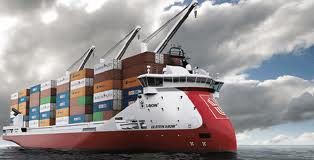
The vessel upsizing trend in the containership sector has resulted in a cascade of larger capacity vessels down through trade routes. While it may be tempting to picture this cascade mechanism as reliant on a rigid route hierarchy, with a delivery schedule strongly weighted towards 8,000+ TEU (VLCS), and mainlane trade growth looking relatively weak, operators are increasingly seeking new homes for cascade candidates in order to manage supply.
Mainlane Cascading
The Graph of the Month displays the percentage of total nominal ship capacity provided by certain vessel size sectors on four key trade routes. 8,000+ TEU containerships now provide 76% of capacity on the Far East-Europe trade, compared to 53% in August 2010, and just 11% at the beginning of 2006. As a consequence, the share of capacity provided by 3,000-7,999 TEU vessels on this trade fell reasonably steadily from 81% in January 2006 to the current level of 24%.
Transpacific routes have traditionally been seen as the first home for large containerships cascaded down from the Far East-Europe trade. At the start of August, 29% of nominal Transpacific route capacity was provided by VLCSs, a proportion that has risen from just 3% over the last five years. Indeed, this year has seen 10,000+ TEU vessels deployed on the Transpacific trade for the first time, although not without some utilisation difficulties. These issues, along with other limitations, suggest that the scope for further cascading here may be finite.
North-South Trades
Meanwhile, between 2006-10 the proportion of capacity provided by 3,000-7,999 TEU boxships on North-South trades increased rapidly (to around 60%) before stabilizing. However, the cascade down to these routes did not cease, rather the deployment of even larger 8,000+ TEU vessels on North-South routes accelerated. For example, the 27 VLCSs currently deployed on Far East-Latin America trades now account for over 20% of route capacity, providing another home for high capacity boxships.
Alternative Cascading Options
A key factor in determining the future path of the cascade is port development. Relatively few global ports are capable of handling the largest containerships, placing severe constraints on carrier deployment options. However, some major ports in the Middle East are equipped to receive VLCSs, providing an important opportunity for cascading. Indeed 55% of Far East-Middle East route capacity, including ME calls on FE-Europe services, is on VLCSs, and 34% on 10,000+ TEU ships.
So perhaps a slightly broader appreciation of the cascade spectrum is required. Some North-South and non-mainlane East-West trades, although not as large in total volume terms as the Transpacific trade, have the potential to provide employment for a significant number of VLCSs. This is offering boxship operators further cascading possibilities.
We use cookies to improve your experience. By continuing to use our site, you accept our Cookies, Privacy Policy,Terms and Conditions. Close X